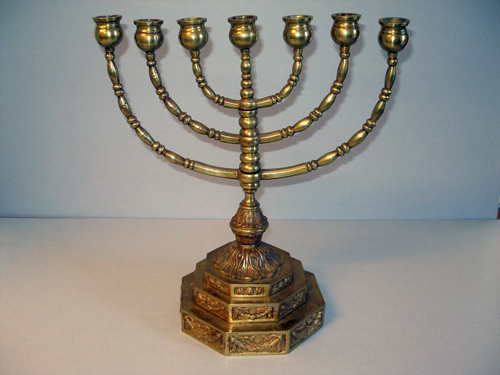
By Alanna Sobel
(c) National Park Foundation
Near Oyster Bay on the North Shore of Long Island, you can walk in the footsteps of the 26th President of the United States. Theodore Roosevelt’s “Summer White House,” as it was affectionately known, is called Sagamore Hill National Historic Site in the park world.
Heirlooms, hunting trophies, and souvenirs light up the 23 rooms of this house and fill visitors’ minds with ideas about who President Roosevelt was and what was important to him and his family.
In one of these rooms, you step through an archway of two African elephant tusks and find yourself surrounded by treasures. Measuring 30 feet by 40 feet, this space is called the North Room and was added to the home in 1905 to host social gatherings and special events.
Among those treasures are two golden menorahs.
I’ve read that a 1909 photograph shows the menorahs on top of the bookcase in the front of the North Room and a 1948 photograph has them placed on top of the bookcase in the back of the same room.
The fact that President Roosevelt valued these menorahs so much that they were out on display and are now part of a park is incredibly special to me. Time and time again, national parks and their programs show me that the National Park System is as diverse as we are as individuals. I had no idea that a park honoring the life and legacy of President Roosevelt would have a connection to my Jewish faith.
The story goes that the two menorahs were given to President Roosevelt by Mrs. Leavitt of New York City, who is described in park records as a close friend of Martha Bulloch Roosevelt and Theodore Roosevelt, Sr. For artifact-lovers like me, here is a letter dated September 4, 1883, from Theodore Roosevelt to his mother, Martha, in which he asks his mother to send his Aunt and Mrs. Leavitt his regards.
While Mrs. Leavitt and her husband were descendants of many generations of theologians, abolitionists, and Congregationalist ministers, and were known to care deeply about religion and theology, there is no indication that they were Jewish.
Having said that, the two seven-armed menorahs are symbolic of the Jewish religion. I specify seven arms because this style is different than the nine-armed Chanukiahs, which are lit when celebrating Chanukah.
While not much else is known about Mrs. Leavitt nor the menorahs, their existence is enough to help me feel like I’m part of the story too.
Maybe someday someone who is admiring all the home’s furnishings will recognize the menorahs and add their knowledge to this story. That is one of my favorite things about our national parks: every time we visit, we enrich these places and help the park community tell a more complete story.
*
Alanna Sobel is a senior manager of communications at the National Park Foundation. The original article may be read at